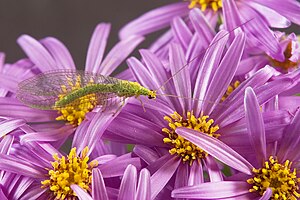Portal:Insects/Selected picture
Nominations
Promoted articles
Featured pictures at Wikipedia or Wikimedia Commons can be automatically included without consensus. Valued pictures here at the Wikipedia can be included automatically as well. To include a featured picture or valued picture, simply choose the next selected picture number from the archive below, click the red link, and paste the following code:
{{Portal:Insects/Selected picture/Layout
|image=
|size= 300px
|status=
|credit=
|text=
|link=
}}
Be sure to fill in the parameters. Place the file name (excluding FILE:) in the image field and provide a suitable caption in the text field. Give credit to the creator. If a Wikipedian created the image, use the format [[User:USERNAME|USERNAME]]. Provide a relevant link to an article that covers the subject. Do not use brackets for the link. By default, the size is left at 300px. Feel free to be bold and change it if necessary.
If the image is a featured picture here in Wikipedia, paste FP into the status field. For a featured picture at Commons, paste FPcommons. Paste VP if the image is a valued picture.
Archive
Selected picture 1
Portal:Insects/Selected picture/1

Simosyrphus grandicornis is an Australasian species of hoverfly (Diptera: Syrphidae), and is one of the two most common hoverflies in Australia, alongside Melangyna viridiceps. Pictured above is a pair of S. grandicornis mating in flight.
Selected picture 2
Portal:Insects/Selected picture/2

Gryllotalpa brachyptera is a mole cricket (Orthoptera: Gryllotalpidae), native to Australia. Mole crickets are thick-bodied insects about 3–5 cm (1.2–2.0 in) long, with large beady eyes and shovel-like forelimbs highly developed for burrowing and swimming. The adult mole cricket may fly as far as 8 kilometres (5.0 mi) during the mating season, is active most of the year, and spends the winter in hibernation.
Selected picture 3
Portal:Insects/Selected picture/3

The rose chafer Cetonia aurata (Coleoptera: Scarabaeidae) is a beetle, 20 mm (¾ in) long, that has metallic green coloration.
Selected picture 4
Portal:Insects/Selected picture/4

Panorpa communis, the common scorpionfly (Mecoptera: Panorpidae), is a species of scorpionfly native to Western Europe.
Selected picture 5
Portal:Insects/Selected picture/5

The Meadow Argus, Junonia villida (Lepidoptera: Nymphalidae), is a butterfly commonly found in Australia. It is also known as Albin's Hampstead Eye in the United Kingdom, where it has occurred only as an accidental import.
Selected picture 6
Portal:Insects/Selected picture/6

Reduviidae (Hemiptera) is a large, cosmopolitan family of predatory insects, including the assassin bugs (genera include Melanolestes, Platymeris, Pselliopus, Rasahus, Reduvius, Rhiginia, Sinea, Triatoma, and Zelus), wheel bugs (Arilus cristatus) and thread-legged bugs (the subfamily Emesinae, including the genus Emesaya). There are about 7,000 species altogether, making it one of the largest families in the Hemiptera.
Selected picture 7
Portal:Insects/Selected picture/7

Mayflies (subimago of Rhithrogena germanica pictured) comprise around 2,500 species of insects which belong to the Order Ephemeroptera. They are aquatic insects whose immature stage usually lasts one year in fresh water, while the adults are short-lived, surviving from a few minutes to a few days.
Selected picture 8
Portal:Insects/Selected picture/8

Green lacewings (Neuroptera: Chrysopidae) is a family of lacewings containing about 85 genera and (according to different sources) 1,300–2,000 species. Members of the genera Chrysopa (pictured) and Chrysoperla are very common in North America and Europe; they are very similar and many of their species have been moved from one genus to the other times and again.
Selected picture 9
Portal:Insects/Selected picture/9

The yellow fever mosquito, Aedes aegypti (Diptera: Culicidae), is a mosquito that can spread the dengue fever, Chikungunya and yellow fever viruses, and other diseases. It can be recognized by white markings on legs and a marking in the form of a lyre on the thorax.
Selected picture 10
Portal:Insects/Selected picture/10

Insects are the only group of invertebrates known to have evolved flight. Insects possess some remarkable flight characteristics and abilities, still far superior to attempts by humans to replicate their capabilities.
Selected picture 11
Portal:Insects/Selected picture/11

Abantiades latipennis (Lepidoptera: Hepialidae) is one of fourteen species in the Australian genus Abantiades. It thrives in regrowth forests that were previously clearfelled; the phytophagous larvae of A. latipennis feed primarily on the root systems of two species of tree, Eucalyptus obliqua (messmate stringybark) and Eucalyptus regnans (mountain ash).
